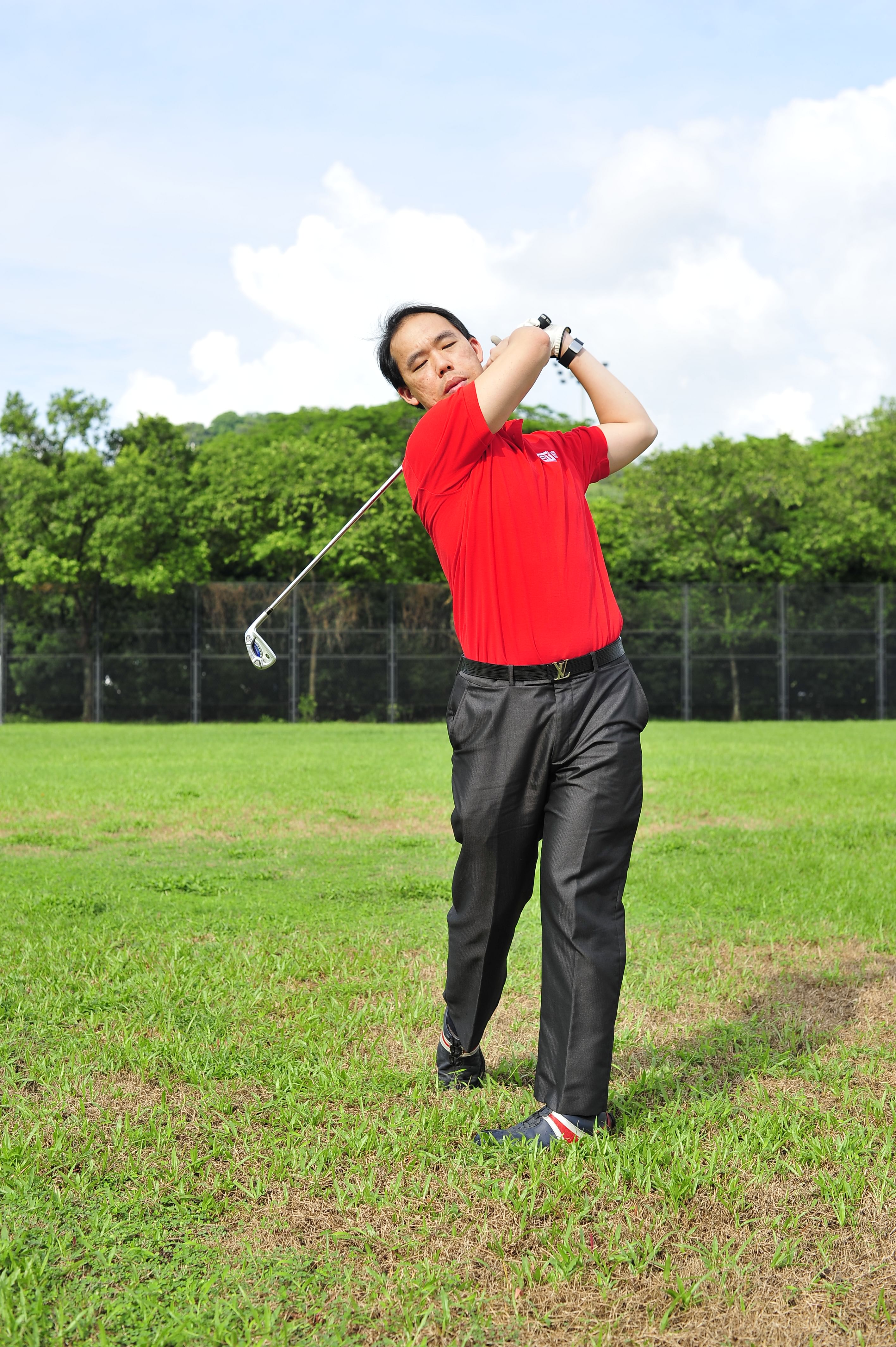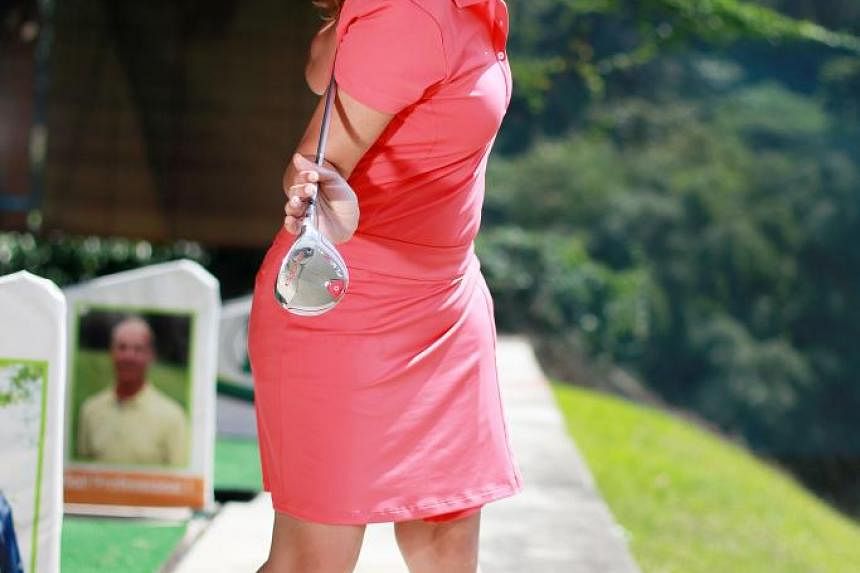Golf as a sport offers plenty of health benefits.
Just walking around the golf course can increase your exercise tolerance, which helps to improve cardiovascular fitness, said physiotherapist Benjamin Soon, an assistant professor at the Singapore Institute of Technology (SIT).
Swinging the golf club improves the body's flexibility and helps to increase one's muscle tone and endurance, he said.
This swinging action also boosts a golfer's postural awareness, coordination and mental alertness.
On top of that, the sport helps the player to improve his psychological and social well-being.
This is because golf is a social sport and provides opportunities to stay in touch with friends and colleagues, he added.
THE PROPER SWING
Before you can reap the full benefits of this exercise, you have to be able to swing the golf club properly.
-
You still have time to sign up if you want to join senior presenter of Kiss 92, SPH Radio, Ms Claressa Monteiro (left), at the Her World Golf Challenge.
Venue: Sentosa Golf Club (Tanjong Course)
When: July 3
Time: 11am to 9.30pm
Format of play: Double Peoria System (Stableford)
Registration fee: $289 (includes lunch and dinner)
To register: Call 6319-1458, e-mail ngoisw@sph.com.sg or go to campaign.herworldplus.com/herworldgolf2015/.
The golfer has to understand aspects such as good spinal alignment, posture and back muscle control, which also play an essential role in helping the person maintain a good posture in daily activities, said Prof Soon.
For example, a golfer needs to make sure his back and neck are straight as he prepares to swing the golf club.
This movement also translates to a good posture in everyday life, as it trains the person to correct a slouching posture when he stands or sits down.
Flexibility is important to achieve a fluid, powerful golf swing, said Prof Soon, who is the programme director designate for academic programmes at SIT.
To increase the power of your swing, it may help to do stretches to increase flexibility in the chest area, the back and sides of the torso between the lowest ribs and the pelvis, shoulder and hip, he added.
Stiffness in these joints may cause overuse injuries, as the person would rely too much on his arm strength to perform the swing, rather than make use of the muscles in the trunk, said Prof Soon.
This can be done with the help of specially designed exercises targeting stability, balance and control of the core muscles, such as pilates, said Prof Soon.
FLEXIBILITY AND AGEING
As we age, our general flexibility tends to worsen, as joint articulation (the location where bones connect) may change due to degeneration on the joint surfaces, said Prof Soon.
For example, older people would generally have stiffer spines and joints, compared with younger people.
The different stages of a golf swing requires coordinated movement from various joints, such as the hip (pelvis), spine, shoulder, elbow and wrist.
A reduction in mobility of any one of these joints will affect the rest of the movement, he said.
For example, a reduction in spinal rotation may mean that the hip joint (pelvis) has to twist further to compensate for the lack of torso rotation during the golf swing.
In the long term, this may result in hip and back pain, said Prof Soon.
Not doing the golf swing properly may give rise to other health dangers. An insufficient torso rotation during the backswing, for instance, can cause shoulder impingement when the dominant arm gets too close to the chest.
Excessive twisting motion of the pelvis and spine to gain more power and force during the downswing may strain the discs in the lower spine, which can lead to lower back pain, said Prof Soon.
Shifting one's weight from one foot to another during a golf swing is a key component of a good swing.
Golfers who do not transfer their weight sufficiently may experience back strain, he added.
Overuse of the forearm (wrist and elbow) muscles instead of core muscles during a golf swing may result in injuries, such as golfer's or tennis elbow, which are muscular strains on the inner and outer parts of the elbow.
People with golf-related injuries should seek further treatment or advice from a professional physiotherapist.
LIMBER UP
To keep your body limber, do warm-up exercises.
These should include both static and dynamic stretching of all the major muscle groups involved in the golf swing.
These comprise muscles around the torso, the hamstrings in the legs, deltoid in the shoulder, pectoral major in the chest, and the various muscles which control the wrists, hands and elbows.
One set of static stretches for each muscle group, which involves holding each position for 15 seconds and ending with 30 seconds of mimicking the golf swing without holding the club or "air swinging", would be sufficient, said Prof Soon.
AGE IS NO BARRIER
Ms Claressa Monteiro, 45, a senior presenter at Kiss 92, SPH Radio, is a recent regular golfer who is trying to do it right.
Since picking up the game this year, she has not suffered an injury from playing golf.
She hits the driving range three times a week and plays at least nine holes once a week.
"Any exercise is good, and golf ticks all my boxes. Being outdoors and breathing in fresh air while getting exercise is perfect," she said.
Her greatest challenge is finding the time to play.
The game takes time, be it on the golfing or driving range, she said.
A game of nine holes takes about two hours, while 18 holes takes over four hours.
"Hitting 100 balls at the range usually takes over an hour because I'm correcting errors as I go along and taking lots of practice swings in between hitting balls," she said.
To keep herself flexible and injury-free, she does a little yoga to stay limber and lifts some free weights at home.
As she has tendinitis (tendon inflammation) from years of water skiing, she is careful not to push herself too hard when playing golf.
"Sometimes, I do need to tape my wrist and forearm for additional support," she said.
She recommends golf to anyone who enjoys social interaction and wants to pair that together with exercise.
"Golf is unique in that it's one of the few forms of exercise where age and medical conditions don't preclude you from playing," she said.
One can pick up the game at any age, unlike some challenging sports such as skiing or diving, where it is more difficult to get started at an older age.
"I look forward to being 75 and still actively playing golf," she said.
Ms Monteiro will be taking part in the Her World Golf Challenge next Friday at Sentosa Golf Club.
"One of the hardest things for a lady golfer is to find lady golfer 'kakis'," she said, referring to the Singlish term for buddies. "I decided to take part to widen my group of lady kakis."
Playing it right
Associate Professor Steven Wong, a programme director at Singapore Institute of Technology who manages the information and communications technology programmes, has been a social golfer for 15 years.
He has been trying to improve his golf swing without getting injured.
He demonstrates how it should be done in order to avoid injuries, accompanied by tips from physiotherapist and assistant professor Benjamin Soon.
A. Do warm-up exercises before golfing. First, stand with the back and neck straight.

Then position your legs slightly apart, with your weight spread evenly on both feet. You should be standing roughly parallel to the direction you want to hit the ball.

B. Flex both knees slightly, bend from the hips while keeping the back straight. Take care to avoid bending the thoracic spine (at the mid- to upper-back), as well as excessive arching of the lumbar spine (lower back).

Backswing: Ensure that your torso rotates sufficiently as you lift the golf club behind and over your shoulder during the backswing to avoid suffering a shoulder impingement.

Downswing: Transfer your weight from the back foot to the front foot as you increase the speed of the swing to hit the ball. This reduces the risk of back strain.

C. During and after hitting the ball, use your core muscles, instead of the forearms (wrist and elbow), to generate speed for the swing.
Keep the arms extended as you hit the ball.

This helps to prevent the leading elbow from popping up, which may also cause elbow strain.
The popping-up effect, commonly known as the "chicken wing", is the outward buckling of the left elbow (for a right-handed golfer) in the downswing and during impact.
If the swing is fluid, the follow-through should naturally lead to an end position that is poised, balanced and facing the target.



